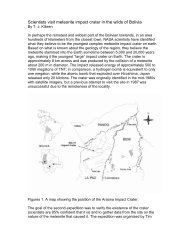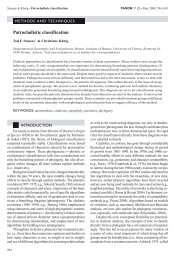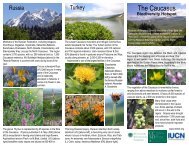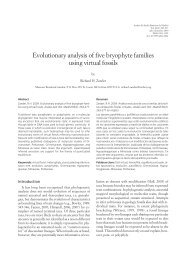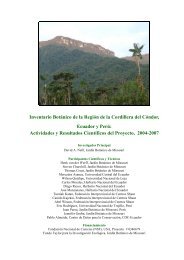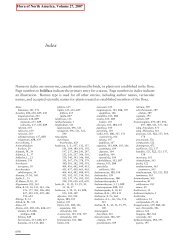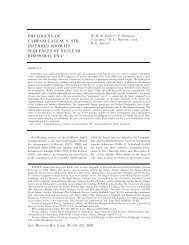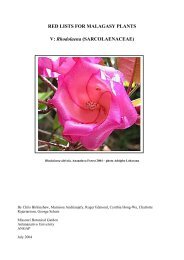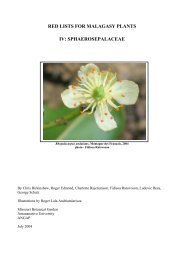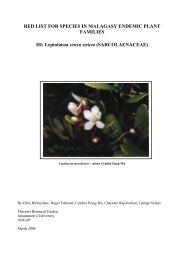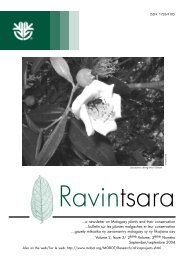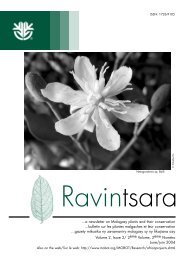re-evaluation of tortella - Missouri Botanical Garden
re-evaluation of tortella - Missouri Botanical Garden
re-evaluation of tortella - Missouri Botanical Garden
Create successful ePaper yourself
Turn your PDF publications into a flip-book with our unique Google optimized e-Paper software.
inclinata var. inclinata from the th<strong>re</strong>e species just<br />
named. Specimens with an adaxial groove <strong>of</strong> elongate,<br />
smooth cells on the surface <strong>of</strong> the costa throughout the<br />
leaf and with leaves that a<strong>re</strong> not cucullate but only acute<br />
with a short mucro, may be T. inclinata var. densa<br />
instead. Thickened abaxial and adaxial superficial cell<br />
walls seen in lamina cross-section will also indicate that<br />
variety.<br />
No small, terminal propaguliferous shoots, as<br />
mentioned for English plants <strong>of</strong> Tortella inclinata var.<br />
inclinata by Smith (1978), we<strong>re</strong> observed or <strong>re</strong>cognized<br />
in North American material. Any terminal filaments<br />
proved to be associated with archegonia, and comprised<br />
the distinctive setaceous apices <strong>of</strong> perichaetial leaves.<br />
Lack <strong>of</strong> such shoots in American material may indicate<br />
that European plants could be a somewhat diffe<strong>re</strong>nt<br />
taxon. Nyholm (1989) for example, stated that in<br />
Scandinavia: "Short fragile yellow-g<strong>re</strong>en apical shoots<br />
a<strong>re</strong> characteristic for this species." Nyholm indicated<br />
that such shoots a<strong>re</strong> important in diffe<strong>re</strong>ntiating the<br />
species from T. densa and T. rigens. It is possible that<br />
these shoots a<strong>re</strong> simply elongations <strong>of</strong> the main stem<br />
axis and a<strong>re</strong> no mo<strong>re</strong> deciduous than the whorls <strong>of</strong> the<br />
var. densa which disarticulate <strong>re</strong>adily upon dissection.<br />
Tortella inclinata s.l. has up to the p<strong>re</strong>sent been<br />
the only taxon <strong>of</strong> the genus in North America to have no<br />
epidermal layer on the costa anywhe<strong>re</strong> on the leaf. Only<br />
the narrow, elongated, smooth ste<strong>re</strong>id cells a<strong>re</strong> exposed<br />
on both surfaces <strong>of</strong> the costa. In Europe, this species<br />
sha<strong>re</strong>s this characteristic with T. rigens, T. densa and T.<br />
limosella (Stirt.) Rich. & Wall. (Smith 1978). Tortella<br />
limosella is separated from T. inclinata in the British<br />
flora in part by having distal leaf cells 8–12 µm wide,<br />
whe<strong>re</strong>as cells <strong>of</strong> the latter species a<strong>re</strong> 8–10 µm. North<br />
American T. inclinata var. inclinata <strong>re</strong>gularly attains the<br />
larger cell dimensions, however. In addition to larger<br />
cells, T. limosella has thicker cell walls and these a<strong>re</strong><br />
unipapillose. It was collected once (1906) from dense<br />
patches from a single population on the seacoast in<br />
western Scotland (Smith 1978) and maybe synonymous<br />
with a mo<strong>re</strong> inclusive concept <strong>of</strong> the variability <strong>of</strong> T.<br />
inclinata s.l.<br />
Persson and Weber (1958), when they first<br />
<strong>re</strong>ported Tortella inclinata from North America,<br />
exp<strong>re</strong>ssed doubts that the p<strong>re</strong>viously described North<br />
American Barbula inclinatula C. M. & Kindb. was<br />
distinct from it. Dixon (1924) <strong>re</strong>ported a diffe<strong>re</strong>nt<br />
ecological and distributional <strong>re</strong>gime for European T.<br />
inclinata: "calca<strong>re</strong>ous banks and rocks, usually in<br />
mountainous districts." North American material, for<br />
example, never grows on rocks, but T. inclinata var.<br />
densa does.<br />
Crundwell and Nyholm (1962) stated that the<br />
Müller and Kindberg type <strong>of</strong> Tortella inclinatula was<br />
identical with European T. inclinata as we<strong>re</strong> two<br />
additonal specimens, one from Ontario and from British<br />
Columbia. Stee<strong>re</strong> and Scotter (1978) still, however,<br />
exp<strong>re</strong>ssed some hesitation based on a sense that the<br />
perichaetial leaves <strong>of</strong> the type <strong>of</strong> Barbula inclinatula<br />
we<strong>re</strong> diffe<strong>re</strong>nt from European material. "Macoun's 190<br />
32<br />
in the National Museum <strong>of</strong> Canada (CANM) has<br />
perichaetial leaves that a<strong>re</strong> conspicuously larger and<br />
mo<strong>re</strong> hyaline than those on European material<br />
examined" (Stee<strong>re</strong> & Scotter 1978).<br />
Although Macoun 190 was not available in the<br />
loan <strong>re</strong>ceived from CANM, th<strong>re</strong>e other North American<br />
fruiting specimens we<strong>re</strong> examined: Alberta, John<br />
Macoun, June 27, 1904 (CANM); B.C., Lake <strong>of</strong><br />
Hanging Glaciers, Wilmer, July 21, 1928, MacFadden<br />
4252 (NY); and also what is appa<strong>re</strong>ntly an isotype <strong>of</strong><br />
Tortella inclinatula: B.C., Illicillewaet near Revelstoke,<br />
May 27, 1890, Macoun 188 (NY). These we<strong>re</strong><br />
compa<strong>re</strong>d with fruiting specimens <strong>of</strong> T. inclinata from<br />
Europe (Strasbourg in western France, Switzerland and<br />
Saxony in eastern Germany) among the W. P. Schimper<br />
duplicates at BUF. No significant transoceanic<br />
diffe<strong>re</strong>nces between the perichaetial leaves <strong>of</strong> these<br />
plants we<strong>re</strong> found. None <strong>of</strong> the American perichaetial<br />
leaves exceeded those <strong>of</strong> the European ones excepting<br />
one specimen (Macoun) in which the leaves we<strong>re</strong><br />
perhaps 0.4 mm longer, an unimp<strong>re</strong>ssive magnitude <strong>of</strong><br />
diffe<strong>re</strong>nce. The laminae <strong>of</strong> the perichaetial leaves appear<br />
white-hyaline in all specimens even at low<br />
magnification. If the American material is diffe<strong>re</strong>nt<br />
from European specimens, the perichaetial leaves a<strong>re</strong><br />
not decisive.<br />
The strikingly diffe<strong>re</strong>ntiated perichaetial leaves<br />
<strong>of</strong> Tortella inclinata var. inclinata only occur in<br />
association with fertilized archegonia. When adjacent<br />
perichaetiate unfertilized stems in specimens with<br />
fertilized stems we<strong>re</strong> examined, the perichaetial leaves<br />
we<strong>re</strong> less distinct from the stem leaves—for example,<br />
they we<strong>re</strong> not longer. Numerous specimens <strong>of</strong><br />
unfertilized perichaetiate plants <strong>of</strong> the var. densa from<br />
North America showed much variability <strong>of</strong> the<br />
perichaetial leaves but nothing to distinguish them from<br />
those <strong>of</strong> unfertilized, perichaetiate var. inclinata.<br />
In Tortella inclinata var. inclinata the<br />
setaceous perichaetial leaves may be conspicuous on<br />
dry stems whe<strong>re</strong> they rise mo<strong>re</strong> stiffly above the curled<br />
stem leaves—as is true <strong>of</strong> those <strong>of</strong> T. alpicola, T.<br />
fragilis and T. tortuosa. Such perichaetiate plants,<br />
though uncommon, a<strong>re</strong> easy to confuse with sterile or<br />
fertile T. fragilis, but the setaceous leaves <strong>of</strong> that species<br />
have propaguloid modifications in the apex whether<br />
bar<strong>re</strong>n or fertile. Fertile T. inclinata var. inclinata has<br />
also been confused with T. tortuosa but in the latter<br />
species the lower leaves a<strong>re</strong> also long-mucronate. The<br />
lower leaves in T. inclinata var. inclinata a<strong>re</strong> all<br />
<strong>re</strong>latively blunt or cucullate.<br />
The p<strong>re</strong>sence in some perichaetial leaves (with<br />
fertilized archegonia) <strong>of</strong> an interrupted border <strong>of</strong><br />
elongate, thick-walled smooth cells in the distal portion<br />
<strong>of</strong> the leaf is <strong>re</strong>miniscent <strong>of</strong> perichaetial leaves <strong>of</strong><br />
Tortella tortuosa whe<strong>re</strong> this character is mo<strong>re</strong><br />
pronounced. This characteristic is very important in the<br />
subulate-propaguloid leaves <strong>of</strong> both sterile and fertile<br />
(perichaetial) leaves <strong>of</strong> T. fragilis and seems to<br />
contribute to the rigidity <strong>of</strong> the leaves that possess these<br />
borders in all th<strong>re</strong>e species.





